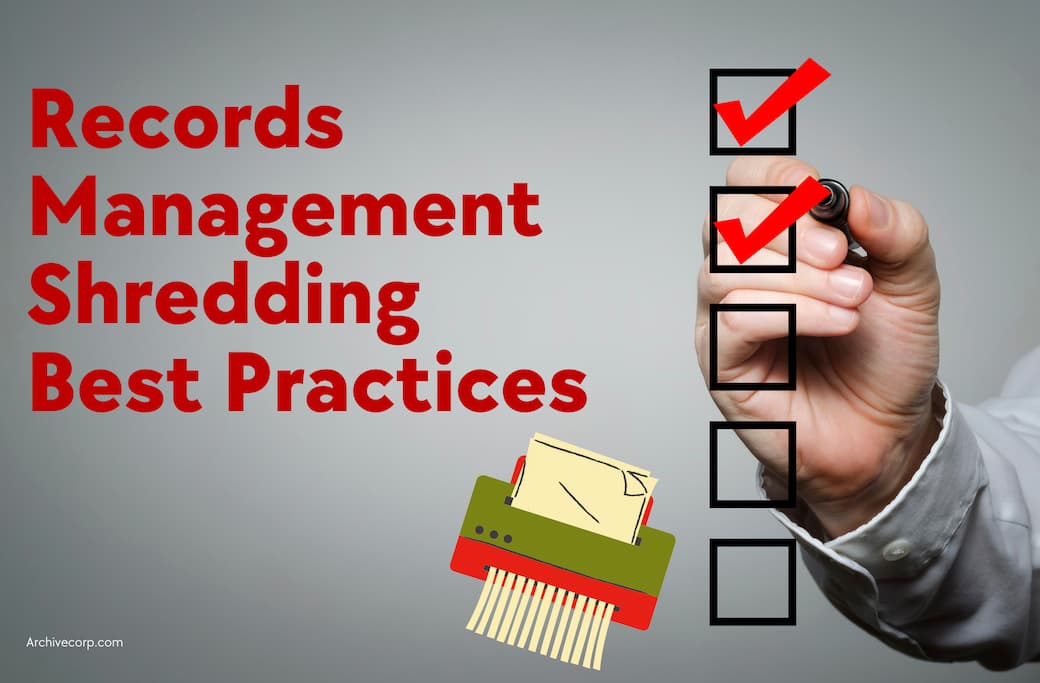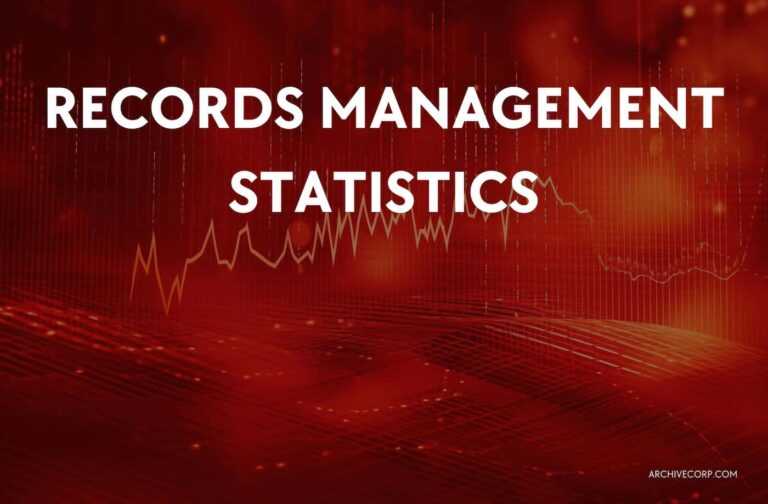Shred with Confidence: 9 Essential Best Practices for Impeccable Records Management
Table of Contents
10,000 sheets of paper. That’s what the average office worker uses each year.
On a corporate scale, it translates to mountains of paper, all with nuggets of information that are as valuable as they are vulnerable.
When these documents pile up over time, they not only lead to clutter but also increased storage costs plus potential security risks.
And that’s where the practice of records management shredding comes into the picture. While records management ensures that your documents are stored, accessed, and disposed of in a secure and efficient manner, document shredding is a disposal method applied at the end of that records management pipeline.
The objective of records management shredding is not merely to get rid of clutter. Rather, it’s a sophisticated process in which advanced shredders destroy business documents in a manner that’s secure, compliant, and efficient.
To get all those benefits, though, you might want to observe the following records management shredding best practices strictly:
5 Best Practices for Document Shredding
#1. Proper Classification and Segregation
Successful shredding begins with accurate document classification and segregation.
By classification, we’re referring to the process of categorizing documents based on their sensitivity and retention requirements. You need to clarify what qualifies as sensitive information that could risk data breaches if mismanaged. These are the documents that should be destroyed immediately after use, unlike business operation documents that you may need to retain for much longer.
Segregation, on the other hand, is all about separating confidential and non-confidential documents. The former are then securely shredded, while the latter are disposed of normally.
For instance, financial records, employee data, and customer information are typically classified as confidential due to the sensitive nature of the details they contain. In contrast, routine office correspondence and other non-sensitive internal documents may not require advanced protection.
#2. Document Destruction Policy
Shredding is not simply about feeding paper into a machine and watching it turn into confetti. The entire exercise must be guided by a strategic media destruction policy.
This serves as a roadmap that guides everyone in your organization on how to handle documents due for disposal. It specifies the shredding process’s what, when, where, and who.
A good destruction policy further details the methods of shredding to be used and the accompanying document shredding best practices to follow.
Here is a sample outline of the principal sections:
- Classification of Documents: This defines what constitutes a confidential document and what doesn’t.
- Shredding Procedures: This part lays out all the steps to be followed when shredding documents.
- Shredding Schedule: This specifies how often shredding should be done. You could choose to do it daily, weekly, or monthly, depending on the volume of documents your organization handles.
- Authorized Personnel: The section identifies who is authorized to perform the shredding.
- Record Keeping: Guidelines for recording and documenting all shredding activities should be provided. You ought to capture the date of shredding, the type of documents shredded, and the person who did the shredding.
- Policy Review: The entire roadmap should be examined regularly to ensure it remains effective and compliant with any changes in laws or regulations.
#3. Secure Storage
Document security is another fundamental consideration that must accompany all records management best practices.
The process itself begins well before the actual shredding. This is where you implement measures to protect sensitive information from prying eyes and unauthorized access.
Consider, for example, investing in ultra-reinforced bins or containers. Each of these storage boxes should be structurally strong, tamper-proof, and lockable to prevent unauthorized access. Ensure they’re also clearly labeled to avoid confusion about their contents.
The physical location of your storage also matters. Companies that observe secure shredding best practices run dedicated storage centers away from their common areas. Their records storage facilities are further monitored around the clock to prevent physical infiltration and information theft.
#4. Regular Shredding Schedule
Avoid the common pitfall of accumulating a mountain of outdated documents for extended periods. Such stacks of papers not only take up valuable office space but also expose you to more security risks.
With a regular shredding schedule, though, you’ll be able to keep your workspace clutter-free while minimizing vulnerabilities.
A consistent shredding schedule also helps to maintain compliance with data protection regulations. As you’ll notice, many industries already have time-specific guidelines on retaining and disposing of certain documents.
It’s worth noting, however, that there’s no single best frequency for shredding documents. What you decide on should be based on the volume of records generated, the industry compliance requirements, and the specific needs of your business.
For example, a company that produces confidential documents on a large scale may need to schedule shredding sessions more frequently than those with fewer sensitive records.
#5. Use of Cross-Cut Shredders:
Your level of document security is also influenced by the type of shredder chosen for the job.
That said, the two most common types that you’ll find out there are strip-cut and cross-cut shredders. Both can destroy documents – but the way they do it and the level of protection they provide are quite different.
As the name suggests, strip-cut shredders cut documents into long vertical strips. This method of shredding is relatively quick and requires less maintenance as the shredder’s gears don’t work as hard.
However, the corresponding security level is lower because the strips, although shredded, could potentially be reassembled. The waste bin must also be emptied more frequently because the long strips take up more space.
Cross-cut shredders, on the other hand, slice papers both lengthwise and widthwise into small confetti-like pieces. Such shreds are much more difficult to reassemble, thus offering superior privacy protection.
The National Security Agency (NSA) defines a level 3 security shred as no larger than 3/16″ x 3″, a standard cross-cut shredders meet and often exceed.
4 Best Practices for Compliance and Record-Keeping
Compliance and record-keeping are both essentials of document shredding, but an intricate set of variables influences them. Managing these variables requires records management shredding best practices that are unique to compliance and record keeping.
#1. Legal Compliance:
In recent decades, state and federal agencies have implemented a barrage of laws governing data management and security. There are now multiple regulations that you’re obligated to follow when handling, storing, sharing, and disposing of documents.
For example, if you’re in the medical industry, your document shredding must comply with the Health Insurance Portability and Accountability Act (HIPAA).
Similar guidelines are contained in the Fair and Accurate Credit Transactions Act (FACTA) and the General Data Protection Regulation (GDPR).
#2. Documentation:
It’s not enough to shred documents – you need to additionally keep a clear record of what has been shredded. This means documenting the date, time, and method of shredding.
A well-organized records management strategy will not only streamline your auditing and compliance but also reassure clients that their information is being protected throughout the destruction process.
#3. Certificate of Destruction:
Speaking of reassurance, you might want to get a Certificate of Destruction as legal proof that your documents have been securely destroyed in compliance with relevant privacy laws. It’s all provided by your shredding service provider after each disposal exercise.
On the certificate, you’ll find details about the date and time of shredding, the method of destruction used, and a unique serial number for tracking purposes.
#4. Employee Training and Awareness:
The human element is often the weakest link in any security chain, and document shredding is no exception. As such, companies are strongly advised to train their employees on the importance of proper document shredding. Those training sessions should cover the potential risks of mishandling sensitive information, plus the roles each employee plays in protecting data.
In addition to training, you should try and foster a culture of security awareness within your organization. This can be achieved by regularly highlighting the significance of information security, sending out reminders about the company’s shredding policy, as well as conducting internal compliance audits.
Shred Smarter, Not Harder
These document shredding best practices are not just boxes to check off – they are integral components of a comprehensive records management strategy. Implementing them can help maintain data security, ensure compliance, and protect your organization from the damaging effects of data breaches.
The only problem is the whole task of document shredding can be daunting, especially for businesses that process a large volume of documents.
But thankfully, you can always rely on Archive Corp as your professional document shredding partner. We are a full-service records management company with custom solutions for businesses like yours.
Trust us to organize your documents, store them securely, and shred everything in line with your industry standards. By so doing, we’ll be safeguarding your business, your reputation, and your peace of mind.
All that’s needed is for you to make the smart choice today and choose Archive Corp as your document shredding partner.



![The Ultimate A-Z Records Management Checklist [2023]](https://www.archivecorp.com/wp-content/uploads/2023/06/records-management-checklist-archivecorp-1-768x504.jpg)



